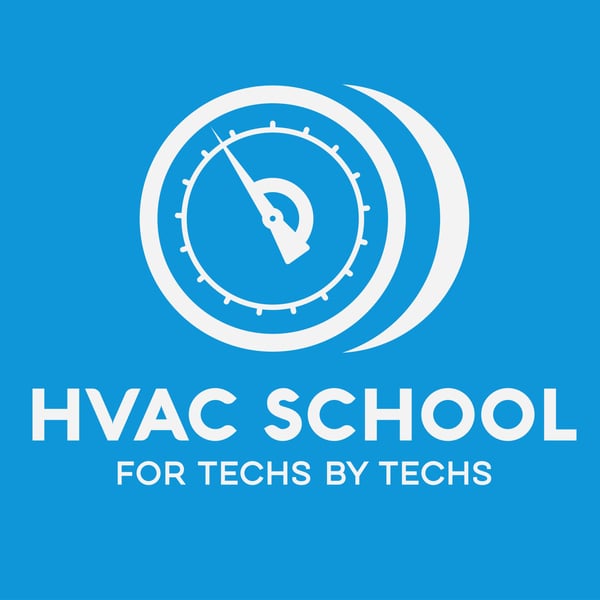Superheat Talk w/ JD Kelly
HVAC School - For Techs, By Techs
Bryan Orr
4.8 • 985 Ratings
🗓️ 15 May 2025
⏱️ 29 minutes
🧾️ Download transcript
Summary
In this episode of the HVAC School podcast, host Bryan discusses superheat with guest JD, who recently co-authored an article on the topic with Ty Branaman. The conversation explores the often misunderstood concept of superheat, its importance in HVAC diagnostics, and common misconceptions technicians have when measuring and interpreting it.
Bryan begins by sharing how superheat was initially taught to technicians in the late 1990s and early 2000s, primarily as a method for charging fixed metering device systems. He explains how this limited view led to problems, as technicians would often add or remove refrigerant based solely on superheat readings without considering other system factors or giving the system time to stabilize. JD points out how the industry shifted when TXVs (Thermostatic Expansion Valves) became standard, with many technicians abandoning superheat measurements altogether in favor of subcooling measurements, missing crucial diagnostic information in the process.
The discussion then evolves into a more sophisticated understanding of superheat as an indicator of evaporator coil "fullness." Bryan explains that lower superheat indicates a fuller evaporator coil, while higher superheat suggests a starved coil. They discuss the importance of measuring superheat in the correct location, noting that TXVs control superheat at the evaporator outlet, not at the condensing unit where technicians often measure. This misunderstanding leads to many incorrect diagnoses of "bad TXVs" when the real issues might be related to airflow, heat pickup in line sets, or other factors. Both experts emphasize the value of measuring superheat both inside at the evaporator outlet and outside at the condensing unit to get a complete picture of system operation.
Key Topics Covered:
- Definition of superheat and its importance in HVAC diagnostics
- How superheat indicates evaporator coil "fullness" (flooded vs. starved conditions)
- The distinction between charging by superheat and using superheat as a diagnostic tool
- Common misconceptions about superheat measurement on TXV systems
- Why measuring superheat location matters (evaporator outlet vs. condensing unit)
- How to properly diagnose TXV issues using superheat measurements
- The relationship between airflow problems and superheat readings
- Normal superheat ranges for residential systems (7-14 degrees at evaporator outlet)
- How superheat affects both system capacity and compressor safety
- "Exercising" TXVs as a troubleshooting technique
- How line set conditions and installation factors can impact superheat readings
- System behavior during "hot pull down" conditions when starting with high indoor temperatures
JD and Ty's superheat tech tip and worksheet: https://hvacrschool.com/solving-superheat/
Have a question that you want us to answer on the podcast? Submit your questions at https://www.speakpipe.com/hvacschool.
Purchase your tickets or learn more about the 6th Annual HVACR Training Symposium at https://hvacrschool.com/symposium.
Subscribe to our podcast on your iPhone or Android.
Subscribe to our YouTube channel.
Check out our handy calculators here or on the HVAC School Mobile App for Apple and Android
Transcript
Click on a timestamp to play from that location
| 0:00.0 | The HVAC School Podcast is made possible by these great partners. |
| 0:09.2 | Navak and the Navak NX1 Nexus Digital Manifold Gage. |
| 0:14.4 | Trust me, I tried it recently. |
| 0:15.9 | You're going to want to check it out. |
| 0:17.5 | It's sturdy. |
| 0:18.2 | It has a great hook. |
| 0:19.2 | Has a great look. |
| 0:20.3 | It connects wirelessly and integrates with the My Navack app. It's sturdy. It has a great hook, has a great look. It connects wirelessly and integrates |
| 0:22.4 | with the My Navak app. It's got the micron gauge. It's got the external temperature clamps |
| 0:27.3 | with a digital display right on the clamps. I think you're going to like it. Find out more. |
| 0:32.3 | HVCRSchool.com slash NX1. |
| 0:35.8 | Refrigeration technologies and their Viper aerosol Coil Cleaner for cadencers and evaporators. |
| 0:42.3 | If you don't know, the Viper Aerosol cleaner is a foaming cleaner that you can spray into a coil with its really powerful pin spray. |
| 0:50.3 | It has a strong degreasing capability in a convenient package. |
| 0:55.2 | It's safe to use with rinsing or no rinse, so there's zero need to bring a bulky pump |
| 1:00.4 | sprayer into the house for an evaporator coil cleaning or in many refrigeration applications. |
| 1:05.7 | And like you mentioned, it works on evaporators and condensers. |
| 1:09.0 | Find out more at refrigetec.com. |
| 1:12.2 | Santa Fe and Santa Fe and Sanofay dehumidifiers. |
| 1:14.4 | They have one of the best product lines in the business and it just got better. |
| 1:17.7 | With their new total peace of mind warranty program that gives your customers a five-year |
| 1:22.9 | complete replacement coverage plus an extra year for parts. |
... |
Please login to see the full transcript.
Disclaimer: The podcast and artwork embedded on this page are from Bryan Orr, and are the property of its owner and not affiliated with or endorsed by Tapesearch.
Generated transcripts are the property of Bryan Orr and are distributed freely under the Fair Use doctrine. Transcripts generated by Tapesearch are not guaranteed to be accurate.
Copyright © Tapesearch 2025.

